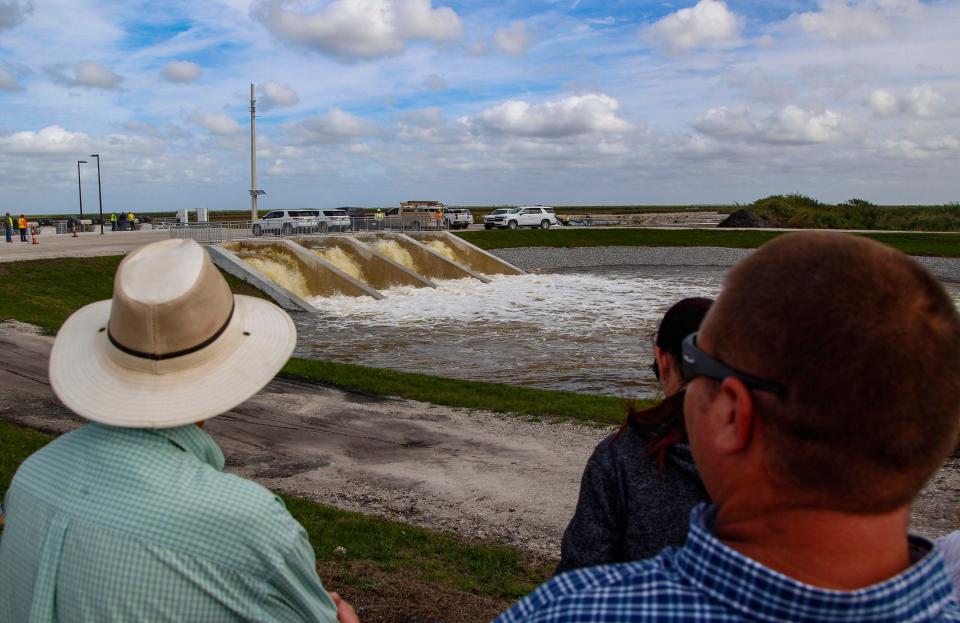Ed Killer: Everglades restoration has a long, expensive way to go
MILES FROM CIVILIZATION — Water poured through four pipes, filling a large canal on a former sugar farm. Culverts under an adjacent road carried the pumped runoff into a flat, expansive field nearby. Just like that, decades of planning and years of rallying funding in Tallahassee and Washington culminated in real action.
The stormwater treatment area (STA) sandwiched between a sugar cane field and the Everglades will one day be fed by a reservoir as large as Manhattan. This wide open, featureless space in the middle of South Florida actually represents a major milestone in the marathon that is Everglades restoration.
I was witness to the pumps being switched on that day. So why do I still have serious questions about one of the nation's largest projects designed to clean and move water?

Does Gov. Ron DeSantis support Everglades restoration?
On Jan. 25, about 300 people celebrated a ribbon-cutting for the STA adjacent to — once it is built — the Everglades Agricultural Area Reservoir. Gov. Ron DeSantis kicked off the ceremony that bright, breezy morning in his first official function two days after suspending his presidential campaign.
DeSantis has described this project as the "crown jewel of Everglades restoration." He's backed that up during his administrations by committing $6.8 billion of state money — $3.3 billion in past budgets and $3.5 billion in future budgets.
The Floridian-in-chief traded much-criticized cowboy boots for black work boots during his trip to the dusty field. He led six speakers and joined 15 other partners to snip a ceremonial ribbon before watching the water flow.
What's the status of EAA reservoir construction?
DeSantis and the Army Corps of Engineers are driving the spear to complete these projects.
The South Florida Water Management District began constructing the STA in 2020 and will finish sometime this summer. For a state government project, that's moving at light speed. But the reservoir the Army Corps is building to feed water into the STA is still going to take a while.
The most recent completion date publicized is now 2032, according to the Army Corps' most recent Integrated Delivery Schedule. Construction problems and funding deficiencies can delay federal government projects, making likely completion a handful of years later than that.
While watching the canal fill that day, I wondered about the lacking science of the reservoir's function. Will this project work as it designed? Here are pros and cons of the EAA Reservoir and STA:
What are the positives?
The STA is done. Pumps began filling Cell No. 1 on Jan. 25.
6,500 acres. Large enough to hold every theme park in Florida, said SFWMD Executive Director Drew Bartlett.
$288 million. Amount Florida paid for STA.
Clean water. Will be able to clean water from EAA Reservoir to send to Everglades.
6 inches. That's how much water it will take off the surface of Lake Okeechobee to send to the reservoir.
What are the negatives?
Reservoir too large for STAs? At 10,000 acres, the reservoir may collect too much water for the STAs to process, a 2022 report by the National Academies suggests
Reservoir too deep? Lake Okeechobee is 4-8 feet deep. The manmade reservoir on flat ground will rise high enough to store 23-27 feet of water like an above-ground pool.
Capacity to move water. Canals to Everglades and Shark River Slough are too narrow to move a high volume of water from the STA to the Everglades. A backup this fall in Water Conservation Area 3 nearby demonstrated this.
10%? Will a 10% reduction in discharges to the Caloosahatchee and St. Lucie rivers make a noticeable difference in the health of those estuaries?
STAs are nearly same size as C-44 STAs. EAA STAs measure 6,500 acres, but C-44 STAs measure 6,300 acres to handle a much smaller reservoir, 3,400 acres vs. 10,000 acres.
More land not on table. There are no negotiations underway between the SFWMD and any land owners in the EAA to increase the size of the STAs.
Where do we go from here?
For years, I've resisted the urge to call the EAA Reservoir "Joe's Pond." The EAA Reservoir and STA began as a 60,000-acre plan in 2017 by outgoing state Sen. Joe Negron of Stuart. Before it was passed, the project had been whittled down to 16,000 acres. Even when there was political will behind a restoration project, there wasn't enough will by landowners.
On Jan. 25, as one speaker after another lauded the project, at least two called out for Negron, expecting the father of the project to be in the crowd. He was noticeably absent. Was he honoring a work commitment or detained for other personal reasons? My guess is he was embarrassed the project was well short of his expectations.
The EAA Reservoir, STA and expansion of the Miami and Broward canals to feed lake water to the reservoir will cost an eye-popping $3 billion, probably more once completed. It's the centerpiece for the $23 billion Comprehensive Everglades Restoration Plan encompassing 63 projects. Only one project has been completed since President Bill Clinton and Florida Gov. Jeb Bush signed CERP some 24 years ago.
The way I see it, too much taxpayers' money is as stake. We can't afford to make a mistake. Let's be sure to get this right before we get too far down a road we can't turn around on.
Ed Killer is an opinion columnist with TCPalm and USA Today Network Florida. This is his opinion. Email him at ed.killer@tcpalm.com.
This article originally appeared on Treasure Coast Newspapers: Ed Killer: Everglades restoration has a long, expensive way to go

